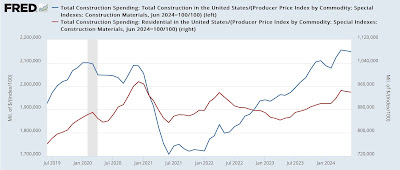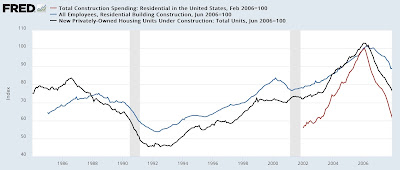Residential building construction and spending sound a warning for goods-producing employment – by New Deal democrat The final data point from last week that I wanted to catch up on was construction spending, and especially residential construction and spending. As reported last week, in June total nominal spending declined -0.3% in June, but is higher 6.2% YoY. The more leading residential sector also showed a -0.4% decline, and is higher by 7.3% YoY: Since producer prices for construction materials declined another -0.1% in May and are down -2.5% YoY, “real” total construction declined -0.2%, while residential construction spending declined -0.3%: Finally, the Inflation Reduction Act, which conferred favorable tax benefits for
Topics:
NewDealdemocrat considers the following as important: residential contruction, US EConomics
This could be interesting, too:
NewDealdemocrat writes JOLTS revisions from Yesterday’s Report
Bill Haskell writes The North American Automobile Industry Waits for Trump and the Gov. to Act
Bill Haskell writes Families Struggle Paying for Child Care While Working
Joel Eissenberg writes Time for Senate Dems to stand up against Trump/Musk
Residential building construction and spending sound a warning for goods-producing employment
– by New Deal democrat
The final data point from last week that I wanted to catch up on was construction spending, and especially residential construction and spending.
As reported last week, in June total nominal spending declined -0.3% in June, but is higher 6.2% YoY. The more leading residential sector also showed a -0.4% decline, and is higher by 7.3% YoY:
Since producer prices for construction materials declined another -0.1% in May and are down -2.5% YoY, “real” total construction declined -0.2%, while residential construction spending declined -0.3%:
Finally, the Inflation Reduction Act, which conferred favorable tax benefits for “restoring,” led to a sharp increase in manufacturing construction spending, which rose only 0.1% for the month – its slowest rate of increase in nine months – to another new record:
Which means it decelerated to a “mere” 19.1% increase YoY. Only one month’s data, of course, but it may mean that the surge is plateauing.
Finally, let me tie this into the discussion of leading employment metrics from the Establishment jobs survey I wrote about on Wednesday. Recall that recessions typically don’t happen until after both manufacturing and residential construction jobs, and more generally goods-producing jobs, have turned down.
As of July, manufacturing jobs are treading water, but construction jobs, and in particular residential construction jobs, were still increasing, as were goods-producing jobs as a whole.
But there is good reason to believe that residential construction jobs will also turn down at some point in the next 6 months.
Here is the historical look at all employees in residential construction (blue), residential construction spending (red), and total building units under construction (black) from the inception of the first two series:
Notice that for the limited history that we do have, building units under construction and nominal residential construction spending have tended to peak simultaneously or close thereto. By contrast, the number of employees in building construction has not peaked until 6-12 months later (presumably, it takes a few months for employers to understand that the Boom is over, and to start laying off their crews).
By the end of last year, residential construction spending and the number of building units under construction both had clearly peaked. The number of building units under construction is now down almost -9%.
Unless there is a sudden turnaround caused by lower mortgage rates, which hasn’t happened on any significant basis as of the present, we should expect layoffs in the residential building trades to start happening within the next few months. That might also cause a peak in goods-producing jobs, which would put employment on a very short-term pre-recession footing.
Yet another reason why the Fed has waited too long to start lowering interest rates, and why they should not hesitate to make a 50-basis point cut in September.
The Bonddad Blog
April housing: Uh-oh, housing units under construction has stopped levitating, Angry Bear by New Deal democrat





